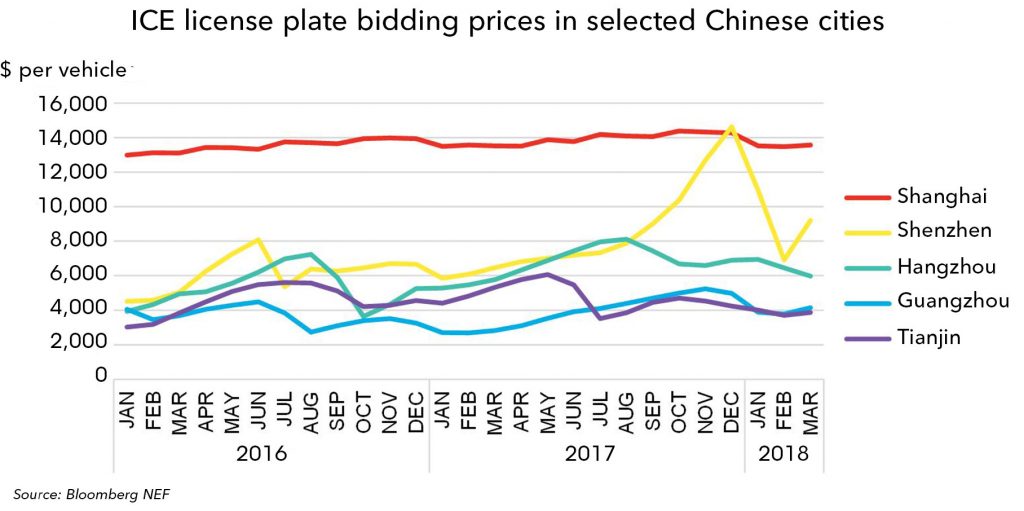Colin McKerracher,
Head of Advanced Transport,
Bloomberg NEF
Automakers are facing a new challenge that’s cropping up from Beijing to Brussels: city regulations pushing them towards cleaner vehicles even faster than national policy goals.
In the past, it was all much simpler. Automakers had to juggle various national and regional policy frameworks – fleetwide CO2 targets in Europe and Corporate Average Fuel Economy Regulations in the U.S., for example – but the well-worn process generally operated with plenty of lead time and with extensive industry input. In the last few years, a potent combination of rising health concerns, emissions scandals, activist pressure and the emergence of real alternatives has led cities to take a more aggressive stance on urban air quality.
China pushes ahead
As with a growing number of areas related to clean energy and transport, China is leading the way. China famously declared war on pollution in 2014, and cleaner vehicles are just one part of a multi-pronged approach. Cities like Beijing, Shanghai, Shenzhen, Guangzhou and Tianjin are making it increasingly difficult to register and drive new internal combustion vehicles. Depending on the city, getting a new vehicle permit requires entering a lottery, an auction, or both. These measures are serious deterrents for would-be buyers. In Shanghai, average new permit auction prices have been around $14,000 for the last few years. In Beijing, the lottery system can mean families wait for several years before getting a new permit.
New Energy Vehicles – China’s term for cars powered by batteries or fuel cells – are generally exempt from these restrictions. The auction prices and the inconvenience of having to wait for years mean many buyers are short-circuiting the process and buying an electric vehicle. It is early days, but these policies are having a big impact. Six Chinese cities accounted for 21% of all EV sales globally in 2017. EV sales in these cities have risen 2-4 times faster than China’s already rapid national average growth rate. They increased eightfold in Beijing since the introduction of these policies, sixfold in Shanghai and fivefold in Tianjin.
The electric vehicle share of China’s overall vehicle market is still small, but it is growing fast. EV sales will hit around 1 million this year, representing close to 4% of all vehicles sold. China’s national auto plan is aiming for EVs to represent around 20% of sales by 2025, but that hides a lot of variation. Because of the municipal policies, adoption in the biggest, wealthiest cities will likely be much higher than this. Those wealthy markets are where global automakers make most of their sales, particularly in the high-end segments. China is the largest auto market in the world. Many automakers are scrambling to figure out just how hard Chinese cities will push these measures and what that means for their vehicle line-up over the next decade.
This is not just a China story. London is introducing an ‘ultra low emissions zone’ beginning in 2019 and expanding it in 2021. Paris plans to ban all diesel and petrol cars from the city center by 2030. German courts recently ruled in favor of allowing cities to introduce bans on diesel vehicles to improve air quality. The list goes on. Both the UK and France have long-term national phase-out targets for conventional vehicles, but the city regulations are front-running these and the gap may widen further.
Looking ahead
Automakers are unaccustomed to having to deal with this Wild Wild West (or East!) of regulation, and the pressure looks likely to increase further in the coming years. Across Europe, mayors, city councilors and mayoral candidates have air quality at the center of their programs. This looks unlikely to fade –stories containing health risks, billions of dollars at stake, technology changes and global companies have a habit of staying on the front page of local newspapers.
Automakers are already accelerating their plans for electric vehicles. Bloomberg NEF data shows 300 different EV models will be on the market by 2021. Many automakers still have doubts on customer interest, but given the long planning cycles, waiting is less and less of an option. Some automakers will offer electrified versions of almost all their models to act as a hedge in case city and national regulations move even faster. This will still take time, but the shift is coming and cities will play a growing role.
The effect of city policies in the commercial vehicle segment is already being felt. Looking out from the Bloomberg HQ in London, one can see buses on either side of the building with a slight bulge at the top. One of the major bus routes around the office was fully electrified in early 2018, others will follow, and the city is requiring that all new single decker buses be electric by 2020. Cities like Shenzhen have moved even faster, with all 16,000 of their municipal buses now electric. Just a little further up the road in London, a taxi stand with newly installed charging points is giving an iconic London black cab a lunchtime jolt of electricity, another product of stringent city regulations.
Automakers may hark back to simpler times, but the patchwork is here to stay, and city governments will no longer wait for national regulations if they feel the health of residents is at risk.
